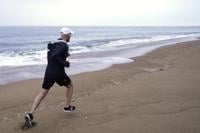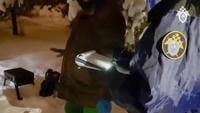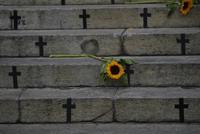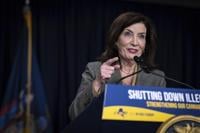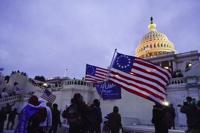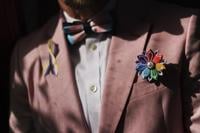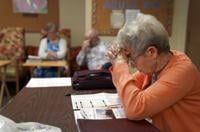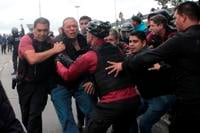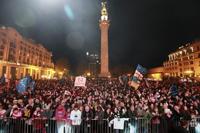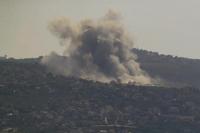BOSTON (AP) — She didn’t even know the Boston Marathon was going on when she wandered out for a walk along Boylston Street. Nor could she understand why someone would run 26.2 miles for “a statement necklace and a banana.”
Then, Adrianne Haslet says, “My life changed.”
The ballroom dancer was standing next to the second of two pressure-cooker bombs that exploded among the spectators watching the finish of the 2013 race. Three people were killed and nearly 300 others wounded. Seventeen people lost limbs in the blast. Haslet was one of them.
She relearned to walk with a prosthetic left leg and vowed to return to dancing. She also set a goal that surprised friends and family who knew her as someone who didn’t like to sweat in public: She would return to the course, this time as a runner.
Haslet completed the race for the first time in 2016, and she is back in the field for Monday's 127th Boston Marathon as the city, the country and fans of the cherished sporting event mark . In the decade since, the streets and sidewalks have been repaired, and memorials at the sites of the explosions remember those who died: Krystle Campbell, Lu Lingzi, Martin Richard.
But the healing continues. And, for many, the race itself is an important part.
Henry Richard, whose brother was 8 when he was killed, ran the marathon in 2022 and plans to do so again this year. Bombing survivors with no previous interest in distance running make it a bucket-list goal; for others, friends and family enter on their behalf. Doctors and first responders and others affected by the attacks are also drawn back to the race on the Massachusetts holiday of Patriots’ Day that commemorates the start of the Revolutionary War.
“We would say in the Navy, ‘Like a fire in the gut,’” says Eric Goralnick, an emergency medicine physician who helped treat the wounded in 2013 and ran the following year.
“I just felt it in my gut. It was something I had to do," he says. “I wanted to feel like this is our city, and this is our event, and it’s the people’s marathon. And I wanted to participate in it and demonstrate that we’re not going to live in fear of terrorists.”
THE RACE
The Boston Marathon isn’t just a race. Or, at least, not just one race.
Up front with the television cameras and trophies, the world’s fittest athletes compete for a prize purse approaching $1 million and the right to claim one of sports’ most treasured titles.
But following them from Hopkinton to Boston's Back Bay on the third Monday in April are 30,000 others who are not in it to win it, or maybe not even to achieve a personal best. They are happy simply to endure, to raise some money for charity, to check a box on some emotional or athletic to-do list.
“The course is the same,” says Jack Fleming, who runs the organization that runs the marathon. “The journeys are very different.”
Since the bombing, the field also includes many who were not marathoners — or even runners — but were drawn to the race as part of the healing process. The Boston Athletic Association waives qualifying for by the attack, including the wounded, their families, and the charities associated with the victims and survivors. This year, 264 One Fund participants will participate.
“It became a ‘take back the finish line’ kind of a piece,” says Dave Fortier, who was hit by shrapnel from one of the bombs and has returned to run the race every year since. “You’re here to say: ‘Not me. Not us.’”
THE FAMILY
The sign is what people remember, showing the youngest Boston Marathon bombing victim expressing a hope that would go unfulfilled: “No more hurting people. Peace.”
The words were when he visited Boston three days after the attacks. And when Henry Richard ran the race in 2022, his singlet said “Peace” in his brother’s youthful scrawl.
Bill and Denise Richard had always gone to the Back Bay to watch the marathon, even before they had kids. It became a family tradition. “It was always a great experience, and then an event that my family attended together,” Henry says.
The Richards were steps away from one of the backpack bombs when it exploded. Martin, 8, died. Jane, his sister, lost her left leg. Denise Richard was blinded in one eye. Bill Richard's eardrums were blown out and he was hit by shrapnel in his legs.
Henry Richard returned to Boylston Street to run the race in 2022, raising his arms in triumph as he crossed the finish line and then collapsing into the arms of his family. He is now 21 and running again this year.
“It was definitely a personal accomplishment that I thought about for a very long time,” he says. “It was a very special day for myself and for my family to finally watch me cross the finish line. I waited years to do it, and I’m glad that it happened and I can continue to do it.”
THE SURVIVOR
Fortier was in the hospital, recovering from a shrapnel wound on his right foot, when he got the email from Boston Marathon organizers congratulating him on completing the race.
“I don’t remember finishing,” he says. “I remember the flash. I remember the heat of it. I remember having my bell rung. … I was helped across the finish line.”
A non-runner, Fortier entered the 2013 race in support of a friend with leukemia. In his training, he never went longer than 20 miles; when he passed that marker on the Boston Marathon course for the first time, he says, “I felt like Magellan sailing off the edge of the earth."
His plan was to be “one and done.” But after , he changed his mind. He was in a meeting with about 30 other survivors when they all got an email from the BAA offering a chance to run the race the following year.
Twenty-eight signed up.
Fortier considers himself lucky. He needed about a dozen stitches in his foot and was out of the hospital that night; he also has hearing loss in both ears. But he would lay awake at night searching for ways to help people still struggling with the aftermath. He founded the One World Strong Foundation, which connects survivors of traumatic events with their peers.
And he kept running.
“The first time I did it, I remember boarding the bus down here, like, ‘What the hell am I doing?’” he says. “And then the following year it was just completely different. It was just happy, seeing the progress that everybody had made."
THE DOCTORS
David Crandell, who runs the amputee program at the Spaulding Rehabilitation Hospital, sometimes calls himself a “last responder.” But he knows that’s not really true.
Even after Crandell has fitted a patient with a new limb, there is still much physical and psychological therapy to come.
Spaulding treated 32 people with blast wounds; the bombs, set on the ground, did much of their damage to feet and legs. The hospital housed the marathon survivors together and brought in war veterans to talk to them – all so they would know they were not alone.
“I had never really taken care of blast injuries before,” Crandell says. “This is a type of injury that you could see in a military conflict.”
The military connection goes both ways, with expertise from the Boston attacks informing care for war wounded.
This spring, Crandell consulted via Zoom with a Ukrainian doctor and his patient. “The soldier from Ukraine is waiting for final adjustments to his left, below-elbow prosthesis so he can return to the fight,” Crandell says.
Goralnick, the emergency medicine specialist, is bringing the lessons learned in the bombing to Ukraine and other conflicts through Stop the Bleed, a program born out of the Sandy Hook Elementary School shootings. The goal: Teach laypeople the effective use of tourniquets and packing wounds to improve the chances of survival while waiting for professionals.
“I don’t use the term ‘first responder.’ Because in my mind, first responder is the public, right? It is the community,” says Goralnick, who had run marathons before but made his Boston debut in 2014. “They’re the ones that are on scene first.”
Goralnick, who was working a post-race clinic near the finish line when the bombs went off, treated the injured at Brigham and Women's Hospital and noticed that almost all of those with lower extremity bleeding had makeshift tourniquets applied. “Many of those were placed by the public, by laypersons,” he says.
Ensuing studies have helped identify the best ways to train non-doctors, including battlefield soldiers, to apply pressure to wounds that might otherwise bleed out. has been translated into Ukrainian and posted on YouTube.
“The thing from the marathon was the recognition that not only do people want to help, but the recognition that they will help,” Goralnick says. “That was a huge ‘Aha!’ moment for us."
THE BOMBERS
Many survivors refuse to speak their attackers' names. Chris Tarpey makes sure to acknowledge them each time he runs past the shoe store where he was injured.
“When I go by, I always throw the finger at Marathon Sports, because I say, ‘Screw you, Tsarnaev brothers,’” says Tarpey, who was hit by shrapnel and needed 14 stitches to close up the wound in his right knee. “Because I’m here, and you’re not.”
Ethnic Chechens who lived in Kyrgyzstan and Russia, Tamerlan and Dzhokhar Tsarnaev became radicalized after moving to the United States as teenagers.
They built a pair of pressure-cooker bombs. They filled them with nails and ball bearings to cause maximum injury. Then they dropped them among the spectators on Boylston Street, steps from the marathon finish line.
The brothers were identified as suspects three days after the bombing. While on the run, they killed MIT policeman Sean Collier and carjacked an SUV, leading to a shootout in which Tamerlan Tsarnaev was wounded. Police say his younger brother ran over him while trying to escape and dragged him 20 feet; he did not survive.
The next evening, Dzhokhar Tsarnaev was found, bleeding, hiding in a boat in a suburban backyard. In 2015, he was convicted on 30 counts, including using weapons of mass destruction; .
“I could never understand. What was their point?" Tarpey says. "What was their message? What was their cause? What were they trying to prove?”
Two months after the bombing, Tarpey’s daughter, Liz, died while hiking in Hawaii. When the BAA offered those affected by the attacks the opportunity to enter in 2014, he ran to raise money for a scholarship in her name; he continued every year until the pandemic broke his streak in 2020.
“You definitely feel like you’ve accomplished something,” he says. “From a healing perspective, it keeps your mind off of issues. That helped me kind of recover, in a way, by making sure that we remember her. And it gives me a way to just mentally get through it.”
Tarpey had been standing right where one of the backpacks was dropped; he had moved up to get a better view, allowing him to escape serious harm. “I think of the marathon bombing as minor compared to what happened with my daughter,” he says.
But both taught him the same lesson: Everything can change in an instant.
“An instant,” he repeats. “Life is precious.”
THE COP
Like a lot of locals, Bill Evans grew up with the Boston Marathon -- watching his brothers run the race or otherwise enjoying the day off from school on the Patriots’ Day holiday. He wasn’t tempted.
“At the time, I’m thinking they needed their head examined,” he says. “Like, who in their right mind would do it?”
Evans didn’t start running at all until his 20s, to deal with the stress of his job as a police officer. Early morning six- or seven-milers was plenty long enough. Then: "I got the bug."
He ran Boston for the first time in 1988, and returned every year – one of the “streakers” who complete the race at least 10 and . In 2013, when Evans was the city's chief of patrol, he crossed the finish line at 1:39 p.m., a net time of 3 hours, 34 minutes, 6 seconds, and went to the gym to soak in a hot tub.
He was back at the course a half hour later. On duty.
“I just can’t fathom what I’d seen, when I had just run down that street an hour earlier,” Evans says.
“Boston Strong” became the city's rallying cry, and it spilled into the city’s other sports. Red Sox slugger and declared, “This is our (expletive) city.” The Boston Bruins went to the Stanley Cup Final. and brought the trophy to the finish line.
But the return of the marathon in 2014 was tense. Fears of another attack loomed. Recently promoted to commissioner, Evans struggled to find the middle ground between making everyone feel safe and turning the event into an “armed camp.”
And he knew he would not be able to run in the race.
"It’s tough to watch. But I knew I had to,” he says in his memorabilia-filled office at Boston College, where he is now the police chief. “I knew my responsibility was putting that race back together.”
Evans was patrolling near Kenmore Square, the 1 Mile to Go marker; he says he felt goosebumps when American Meb Keflezighi ran past . A few hours later, at the time of the bombing, Evans was overcome with relief.
“I remember 2:48 passing that afternoon,” Evans says. “The bells were ringing and everybody was sort of on edge.
“I was just sort of overwhelmed that nothing bad happened after the year before,” he says. “I think we’re all still living with those tragic days 10 years ago.”
THE CHAMPIONS
When Keflezighi meets people from Boston, they don’t say “Congratulations.” They say, “Thank you.”
“That affirms that I was a small piece of that healing process,” he says.
A four-time Olympian, Keflezighi was a spectator in Boston in 2013. He left the finish line about five minutes before the bombs exploded.
“I remember vividly saying, ‘I hope to be healthy enough to win it for the people next year,’” he says.
It was an unlikely goal.
It had been three decades since an American man had won in Boston — before the addition of prize money in 1986 began drawing the top international professionals. Keflezighi was about to turn 39, five years removed from his victory in the New York Marathon and 10 since he won silver at the Athens Games. There were 16 faster runners in the field.
But it was Keflezighi who came down Boylston Street in the lead, the names of the bombing victims written on his race bib and chants of “USA!” ringing out from the crowd. He posted a personal best of 2:08:37.
“It’s not how fit you are. Sometimes (it’s) to just be in the right place at the right time,” Keflezighi says. “My heart was in the right place.”
Keflezighi has grown close with the Richard family. He returned to Boylston Street last year to hang the finisher's medal around Henry Richards' neck. Other Boston champions have also connected with the cause: Five-time wheelchair division winner Tatyana McFadden competed in a Martin Richard Foundation singlet, as has 1968 winner Amby Burfoot. Olympic silver medalist and 2017 New York Marathon champion Shalane Flanagan helped Haslet train; 1976 Boston winner Jack Fultz worked with Fortier.
“That's the cool thing about these races, that everybody on the start line has a story,” 2018 women’s winner Des Linden says. “That’s so inspirational. And I think so many of those stories came out of that, the bombing year.
“It’s very moving,” she says. “And I think it is to the point: We’re going to get up, and keep pressing forward.”
___
AP Sports Writer Jimmy Golen has covered the Boston Marathon since 1995.


